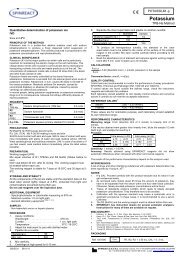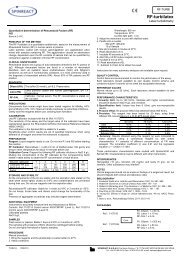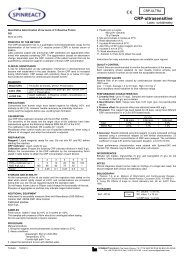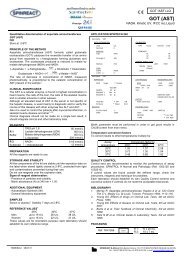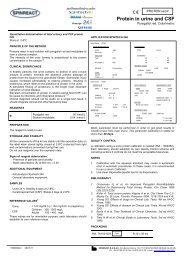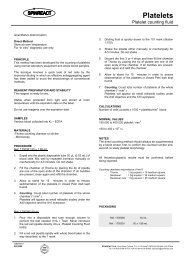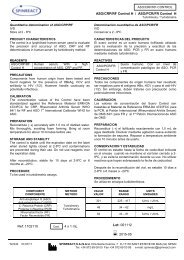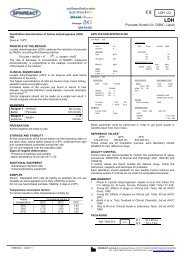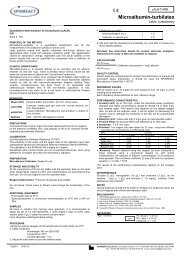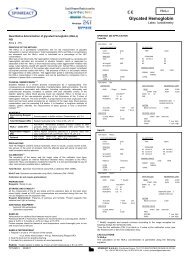Bilirubin Total
Bilirubin Total - Spinreact
Bilirubin Total - Spinreact
- No tags were found...
You also want an ePaper? Increase the reach of your titles
YUMPU automatically turns print PDFs into web optimized ePapers that Google loves.
BILIRUBIN T- DMSO<br />
<strong>Bilirubin</strong> <strong>Total</strong><br />
DMSO. Colorimetric<br />
Quantitative determination of bilirubin<br />
IVD<br />
Store at 2-8ºC<br />
PRINCIPLE OF THE METHOD<br />
<strong>Bilirubin</strong> is converted to colored azobilirubin by diazotized sulfanilic acid<br />
and measured photometrically. Of the two fractions presents in serum,<br />
bilirubin-glucuromide and free bilirubin loosely bound to albumin, only the<br />
former reacts directly in aqueous solution (bilirubin direct), while free<br />
bilirubin requires solubilization with dimethylsulphoxide (DMSO) to react<br />
(bilirubin indirect). In the determination of indirect bilirubin the direct is also<br />
determined, the results correspond to total bilirubin.<br />
The intensity of the color formed is proportional to the bilirrubin<br />
concentration in the sample 1,2,3 .<br />
CLINICAL SIGNIFICANCE<br />
<strong>Bilirubin</strong> is a breakdown product of hemoglobin.<br />
It is transported from the spleen to the liver and excreted into bile.<br />
Hyperbilirubinemia results from the increase of bilirubin concentrations in<br />
plasma.<br />
Causes of hyperbilirubinemia:<br />
<strong>Total</strong> bilirubin: Increase hemolysis, genetic errors, neonatal jaundice,<br />
ineffective erythrpoiesis, and drugs.<br />
Direct bilirubin: Hepatic cholestasis, genetic errors, hepatocellular<br />
damage 1,6,7 .<br />
Clinical diagnosis should not be made on a single test result; it should<br />
integrate clinical and other laboratory data.<br />
REAGENTS<br />
R 1<br />
Sulfanilic acid<br />
Hydrochloric acid (HCl)<br />
Dimethylsulphoxide (DMSO)<br />
30 mmol/L<br />
50 mmol/L<br />
7 mol/L<br />
R 2 Sodium nitrite 29 mmol/L<br />
Optional BILIRUBIN CAL Ref: 1002250<br />
PRECAUTIONS<br />
R1/RT: Corrosive (C):R35: Causes severe burns.<br />
S26: In case of contact with eyes, rinse immediately with plenty of water and<br />
seek medical advice.<br />
PREPARATION<br />
All the reagents are ready to use.<br />
STORAGE AND STABILITY<br />
All the components of the kit are stable until the expiration date on the<br />
label when stored tightly closed at 2-8ºC, protected from light and<br />
contaminations prevented during their use. Do not use reagents over the<br />
expiration date.<br />
Signs of reagent deterioration:<br />
- Presence of particles and turbidity.<br />
- Color development in R 2.<br />
ADDITIONAL EQUIPMENT<br />
- Spectrophotometer or colorimeter measuring at 555 nm.<br />
- Matched cuvettes 1.0 cm light path.<br />
- General laboratory equipment.<br />
SAMPLES<br />
Serum or plasma, free of hemolysis 1 . Protect samples from direct light.<br />
Stability: <strong>Bilirubin</strong> is stable at 2-8ºC for 4 days and 2 months at –20ºC.<br />
PROCEDURE<br />
1. Assay conditions:<br />
Wavelength: ………………………………………555 nm (530-580)<br />
Cuvette: ………………………………………………1 cm light path<br />
Temperature:………………………………………………….15-25ºC<br />
2. Adjust the instrument to zero with distilled water.<br />
3. Pipette into a cuvette:<br />
Blank B. <strong>Total</strong><br />
R 1 (mL) 1.5 1.5<br />
R 2 ( L) -- 50<br />
Sample (Note 1) / Calibrator ( L) 100 100<br />
4. Mix and incubate for exactly 5 minutes at room temperature.<br />
5. Read the absorbance (A).<br />
CALCULATIONS<br />
With Calibrator:<br />
(A)Sample<br />
(A)Calibrator<br />
(A)Sample Blank<br />
(A)Calibrator Blank<br />
x Conc. Calibrator = mg/dL bilirubin<br />
With Factor:<br />
(A) Sample - (A) Sample Blank x Factor* = mg/dL bilirubin in the sample<br />
*Factor:<br />
Concentrat ionof Calibrator<br />
(A)Calibrator<br />
(A) Calibrator<br />
Conversion factor: mg/dL x 17.1 = mol/L.<br />
; Theoretical factor = 19.1<br />
Blank<br />
QUALITY CONTROL<br />
Control sera are recommended to monitor the performance of assay<br />
procedures: SPINTROL H Normal and Pathologic (Ref. 1002120 and<br />
1002210).<br />
If control values are found outside the defined range, check the instrument,<br />
reagents and calibrator for problems.<br />
Each laboratory should establish its own Quality Control scheme and<br />
corrective actions if controls do not meet the acceptable tolerances.<br />
REFERENCE VALUES 1<br />
<strong>Bilirubin</strong> <strong>Total</strong> Up to 1.10 mg/dL Up to 18.81 mol/L<br />
These values are for orientation purpose; each laboratory should establish<br />
its own reference range.<br />
PERFORMANCE CHARACTERISTICS<br />
Measuring range: From detection limit of 0.099 mg/dL to linearity limit of 18<br />
mg/dL.<br />
If the results obtained were greater than linearity limit, dilute the sample 1/2<br />
with NaCl 9 g/L and multiply the result by 2.<br />
Precision:<br />
Intra-assay (n=20) Inter-assay (n=20)<br />
Mean (mg/dL) 1.12 5.36 1.01 5.28<br />
SD 0.02 0.12 0.03 0.12<br />
CV (%) 2.33 2.27 2.70 2.32<br />
Sensitivity: 1 mg/dL = 0.01540 A.<br />
Accuracy: Results obtained using SPINREACT reagents (y) did not show<br />
systematic differences when compared with other commercial reagents (x).<br />
The results obtained using 50 samples were the following:<br />
Correlation coefficient (r): 0.996.<br />
Regression equation: y= 0.0208 + 0.9884 x.<br />
The results of the performance characteristics depend on the analyzer used.<br />
INTERFERENCES<br />
Hemolysis causes decreased bilirubin values 1,2,3 .<br />
A list of drugs and other interfering substances with bilirubin has been<br />
reported 4,5 .<br />
NOTES<br />
1. For bilirubin determination in newborns, pipette 50 L of sample.<br />
Multiply the result by 2.<br />
2. SPINREACT has instruction sheets for several automatic<br />
analyzers. Instructions for many of them are available on request.<br />
BIBLIOGRAPHY<br />
1. Kaplan A et al. <strong>Bilirubin</strong>. Clin Chem The C.V. Mosby Co. St Louis. Toronto.<br />
Princeton 1984; 1238-1241. 436 and 650.<br />
2. Malloy H T. et al. The determination of bilirubin with the photoelectric colorimeter.<br />
J. Biol Chem 1937; 112, 2; 481-491.<br />
3. Martinek R. Improved micro-method for determination of serum bilirubin. Clin<br />
Chim 1966: Acta 13: 61-170.<br />
4. Young DS. Effects of drugs on Clinical Lab. Tests, 4th ed AACC Press, 1995.<br />
5. Young DS. Effects of disease on Clinical Lab. Tests, 4th ed AACC 2001.<br />
6. Burtis A et al. Tietz Textbook of Clinical Chemistry, 3rd ed AACC 1999.<br />
7. Tietz N W et al. Clinical Guide to Laboratory Tests, 3rd ed AACC 1995.<br />
PACKAGING<br />
Ref: 1001042 R 1:<br />
Cont.<br />
R 2:<br />
2 x 150 mL<br />
1 x 10 mL<br />
BSIS04-I 02/03/12 SPINREACT,S.A./S.A.U. Ctra.Santa Coloma, 7 E-17176 SANT ESTEVE DE BAS (GI) SPAIN<br />
Tel. +34 972 69 08 00 Fax +34 972 69 00 99. e-mail: spinreact@spinreact.com
BILIRUBIN T- DMSO<br />
Bilirrubina <strong>Total</strong><br />
DMSO. Colorimétrico<br />
Determinación cuantitativa de bilirrubina<br />
IVD<br />
Conservar a 2-8ºC<br />
PRINCIPIO DEL METODO<br />
La bilirrubina se convierte en azobilirrubina mediante el ácido sulfanílico<br />
diazotado midiéndose fotometricamente. De las dos fracciones presentes<br />
en suero, bilirrubin-glucurónido y bilirrubina libre ligada a la albúmina, solo<br />
la primera reacciona en medio acuoso (bilirrubina directa) precisando la<br />
segunda la solubilización con dimetilsulfóxido (DMSO) para que reaccione<br />
(bilirrubina indirecta). En la determinación de la bilirrubina indirecta se<br />
determina también la directa, correspondiendo el resultado a la bilirrubina<br />
total.<br />
La intensidad del color formado es proporcional a la concentración de<br />
bilirrubina presente en la muestra ensayada 1,2,3 .<br />
SIGNIFICADO CLINICO<br />
La bilirrubina se origina por la degradación de la hemoglobina.<br />
Es transportada del bazo al hígado y se excreta en la bilis.<br />
La hiperbilirrubinemia es el resultado de un incremento de la bilirrubina en<br />
plasma. Causas más probables de la hiperbilirrubinemia:<br />
Bilirrubina <strong>Total</strong>: Aumento de la hemólisis, alteraciones genéticas, anemia<br />
neonatal, alteraciones eritropoyeticas, presencia de drogas.<br />
Bilirrubina Directa: Colestasis hepática, alteraciones genéticas y<br />
alteraciones hepáticas 1,6,7 .<br />
El diagnostico clínico debe realizarse teniendo en cuenta todos los datos<br />
clínicos y de laboratorio.<br />
REACTIVOS<br />
R 1<br />
Ácido sulfanílico<br />
Ácido clorhídrico (HCl)<br />
Dimetilsulfóxido (DMSO)<br />
30 mmol/L<br />
50 mmol/L<br />
7 mol/L<br />
R 2 Sodio nitrito 29 mmol/L<br />
Opcional BILIRUBIN T CAL Ref:1002250<br />
PRECAUCIONES<br />
R1/RT: Corrosivo (C): R35: Provoca quemaduras graves.<br />
S26: En caso de contacto con los ojos, lávense inmediata y abundantemente<br />
con agua y acudir a un médico.<br />
PREPARACION<br />
Todos los reactivos están listos para su uso.<br />
CONSERVACION Y ESTABILIDAD<br />
Todos los componentes del kit son estables hasta la fecha de caducidad<br />
indicada en la etiqueta, cuando se mantienen los viales bien cerrados a 2-<br />
8ºC, protegidos de la luz y se evita la contaminación durante su uso. No<br />
usar reactivos fuera de la fecha indicada.<br />
Indicadores de deterioro de los reactivos:<br />
- Presencia de partículas y turbidez.<br />
- Desarrollo de color en el R 2.<br />
MATERIAL ADICIONAL<br />
- Espectrofotómetro o analizador para lecturas a 555 nm.<br />
- Cubetas de 1,0 cm de paso de luz.<br />
- Equipamiento habitual de laboratorio.<br />
MUESTRAS<br />
Suero o plasma libre de hemólisis 1 . Proteger de la luz.<br />
Estabilidad de la muestra: 4 días a 2-8ºC o 2 meses a –20ºC.<br />
PROCEDIMIENTO<br />
1. Condiciones del ensayo:<br />
Longitud de onda: . . . . . . . . . . . . . . . 555 nm (530-580)<br />
Cubeta:. . . . . . . . . . . . . . . . . . . . . . . .. .1 cm paso de luz<br />
Temperatura . . . . . . . . . . . . . . . . . . . . . . . . . . . . 15-25ºC<br />
2. Ajustar el espectrofotómetro a cero frente a agua destilada.<br />
3. Pipetear en una cubeta:<br />
Blanco B <strong>Total</strong><br />
R 1 (mL) 1,5 1,5<br />
R 2 ( L) -- 50<br />
Muestra (Nota 1) / Calibrador ( L) 100 100<br />
4. Mezclar e incubar exactamente 5 minutos a 15-25ºC.<br />
5. Leer la absorbancia (A).<br />
CALCULOS<br />
Con Calibrador:<br />
( A)Muestra (A)Blanco Muestra<br />
x Conc. Calibrador = mg/dL de bilirrubina<br />
(A)Calibrador (A)Blanco Calibrador<br />
Con Factor:<br />
(A) Muestra – (A) Blanco Muestra x Factor* = mg/dL bilirrubina en la muestra<br />
*Factor:<br />
Concentrac ión del Calibrador<br />
(A) Calibrador<br />
(A) Blanco<br />
Calibrador<br />
Factor de conversión: mg/dL x 17,1 = mol/L.<br />
; Factor teórico = 19,1<br />
CONTROL DE CALIDAD<br />
Es conveniente analizar junto con las muestras sueros control valorados:<br />
SPINTROL H Normal y Patológico (Ref. 1002120 y 1002210).<br />
Si los valores hallados se encuentran fuera del rango de tolerancia, revisar<br />
el instrumento, los reactivos y el calibrador.<br />
Cada laboratorio debe disponer su propio Control de Calidad y establecer<br />
correcciones en el caso de que los controles no cumplan con las<br />
tolerancias.<br />
VALORES DE REFERENCIA 1<br />
Bilirrubina <strong>Total</strong> Hasta 1,10 mg/dL Hasta 18,81 mol/L<br />
Estos valores son orientativos. Es recomendable que cada laboratorio<br />
establezca sus propios valores de referencia.<br />
CARACTERISTICAS DEL METODO<br />
Rango de medida: Desde el limite de detección de 0,099 mg/dL hasta el<br />
limite de linealidad de 18 mg/dL.<br />
Si la concentración de la muestra es superior al limite de linealidad, diluir<br />
1/2 con ClNa 9 g/L y multiplicar el resultado final por 2.<br />
Precisión:<br />
Intraserie (n= 20) Interserie (n= 20)<br />
Media (mg/dL) 1,12 5,36 1,01 5,28<br />
SD 0,02 0,12 0,03 0,12<br />
CV (%) 2,33 2,27 2,70 2,32<br />
Sensibilidad analítica: 1 mg/dL = 0,01540 A.<br />
Exactitud: Los reactivos SPINREACT no muestran diferencias sistemáticas<br />
significativas cuando se comparan con otros reactivos comerciales.<br />
Los resultados obtenidos con 50 muestras fueron los siguientes:<br />
Coeficiente de regresión (r): 0,996.<br />
Ecuación de la recta de regresión: y= 0,0208+ 0,9884 x.<br />
Las características del método pueden variar según el analizador utilizado.<br />
INTERFERENCIAS<br />
La presencia de hemólisis disminuye el valor de bilirrubina 1,2,3 .<br />
Se han descrito varias drogas y otras substancias que interfieren con la<br />
determinación del bilirrubina 4,5 .<br />
NOTAS<br />
1. Para la determinación de bilirrubina en neonatos, pipetear 50 L de<br />
muestra. Multiplicar el resultado obtenido por 2.<br />
2. SPINREACT dispone de instrucciones detalladas para la<br />
aplicación de este reactivo en distintos analizadores.<br />
BIBLIOGRAFIA<br />
1. Kaplan A et al. <strong>Bilirubin</strong>. Clin Chem The C.V. Mosby Co. St Louis. Toronto.<br />
Princeton 1984; 1238-1241. 436 and 650.<br />
2. Malloy H T. et al. The determination of bilirubin with the photoelectric colorimeter.<br />
J. Biol Chem 1937; 112, 2; 481-491.<br />
3. Martinek R. Improved micro-method for determination of serum bilirubin. Clin<br />
Chim 1966: Acta 13: 61-170.<br />
4. Young DS. Effects of drugs on Clinical Lab. Tests, 4th ed AACC Press, 1995.<br />
5. Young DS. Effects of disease on Clinical Lab. Tests, 4th ed AACC 2001.<br />
6. Burtis A et al. Tietz Textbook of Clinical Chemistry, 3rd ed AACC 1999.<br />
7. Tietz N W et al. Clinical Guide to Laboratory Tests, 3rd ed AACC 1995.<br />
PRESENTACION<br />
Ref: 1001042 R 1:<br />
Cont.<br />
R 2:<br />
2 x 150 mL<br />
1 x 10 mL<br />
BSIS04-E 27/06/11 SPINREACT,S.A./S.AU. Ctra.Santa Coloma, 7 E-17176 SANT ESTEVE DE BAS (GI) SPAIN<br />
Tel. +34 972 69 08 00 Fax +34 972 69 00 99. e-mail: spinreact@spinreact.com



